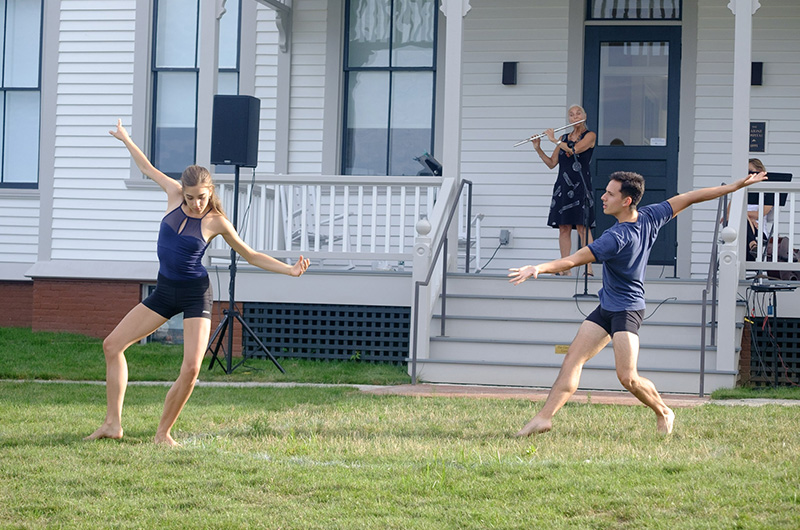The Island’s first socially-distanced classical music concert took place at the Martha’s Vineyard Museum, thrilling an audience that was strictly limited to 25 eager listeners.
From the museum porch, flautist Carol Wincenc and cellist Velléda Miragias played a diverse program that flowed like water into the parched ears of music lovers who sat, in widely-spaced twos and threes, on the lawn below.
As if the music of Bach and Villa-Lobos was not enough joy for Islanders long deprived of live performance, the musicians were joined by two young dancers with the Boston Ballet, Nikolia Mamalakis and Nations Wilkes-Davis, for three very different iterations of Claude Debussy’s short piece Syrinx.
Celebrating the 50th year of her performing career, Ms. Wincenc is known internationally for her mastery of the flute and her support of new music for the instrument. She is a longtime faculty member at the Juilliard School and plays in the New York Woodwind Quintet.
Ms. Miragias is an associate principal cellist with the Boston Philharmonic Orchestra and an organizer of the Safe and Sound series of weekly concerts in orchestra conductor Benjamin Zander’s Cambridge driveway this summer, at which Ms. Wincenc was the principal performer July 5.

A relaxed and expressive presence both on and off the stage, Ms. Wincenc outlined Thursday’s program at the start of the evening and introduced each piece with enthusiasm and insight.
Performing Syrinx with dancers, at three different points during the concert, was her suggestion, Ms. Wincenc said.
“It’s the same piece, but I want to place a bet with you all afterwards that you will see how music almost feels transformed with the different interpretations,” she told the audience. “It’s flute and solo female dancer, flute and solo male dancer and then the concluding work is a pas de deux, to the same Debussy piece from 1912.”
The concert began with Ms. Miragias playing the Prelude from J.S. Bach’s second cello suite in D minor, followed by the first Syrinx.
Debussy’s short work—considered the first modern composition for the flute—tells the story of the god Pan’s doomed passion for the nymph Syrinx, danced here by Ms. Mamalakis at a safe distance of about 15 feet from both the musicians on the porch and the audience on the lawn.
Ms. Wincenc and Ms. Miragias then played The Jet Whistle (Assobio a Jato), a 1950 work by Brazilian composer Heitor Villa-Lobos that builds through three movements to a spectacular flute finale.
Mr. Wilkes-Davis danced as the lovesick Pan in the second Syrinx, which, true to Ms. Wincenc’s prediction, sounded more like the second movement of a suite than a reprise of what she’d played before the Villa-Lobos.
Bach’s flute sonata in D minor was next, with Ms. Miragias’s cello continuo in the keyboard part. Dragonflies darted through the evening air and a light breeze blew as audience members basked in the music.
For the third Syrinx, Ms. Mamalakis and Mr. Wilkes-Davis danced together in their concert finale with Ms. Wincenc, winning rapturous applause.
Thursday’s show was produced and hosted by Vineyard Haven artist Paul Lazes, who partnered with Ms. Wincenc to design the evening.
“This was his vision. This was his creation, and it shows what collaboration can do,” she told the audience.
The amplified sound, by Islander Andy Herr, was notable for its transparency. While clearly audible throughout the far-flung audience, the music was free of the harshness and distortion that can result when electronic reproduction is harnessed to acoustic performance.
“The cello was full and warm. There was no buzzing,” said Island pianist Adele Dreyer, who has been playing for artist receptions at Cousin Rose Gallery in Oak Bluffs this summer.
Along with producing the concert, Mr. Lazes also created one of two dioramas installed on the museum lawn.
The first diorama, by his brother Rick Lazes, is a slice of mid-20th-century interior, complete with wallpaper and framed portraits, containing six old-fashioned television sets playing footage of such bygone figures as the Three Stooges, Lucille Ball, Andy Griffith and John F. Kennedy.
Titled Tune In, the work is accompanied by an artist’s statement that questions whether, in the era of digital devices that has replaced the television age, humans have become isolated from one another.
“Perhaps it is time to tune out the distraction of the static emanating from the internet and social media,” Rick Lazes wrote. “Can we create a better picture this time?
In the second diorama, titled Choice, Paul Lazes set a postmodern family of store mannequins against a backdrop of the Tashmoo Overlook, to present what he said is a hopeful vision of the future.
Warming up on flute before the concert, Ms. Wincenc entered literally into the spirit of the piece, stepping onto the floor of the diorama to play a few phrases from the Mexican “hat dance,” El Jarabe Tapatio by Jesús González Rubio, for the mannequins.
More Thursday night events outside the museum are scheduled for later this month, Mr. Lazes said. On August 20, Island writers Julia Kidd, Jenny Allen and Nancy Aronie will read, and on August 27, the Pickpocket Bluegrass Band will play.







Comments
Comment policy »